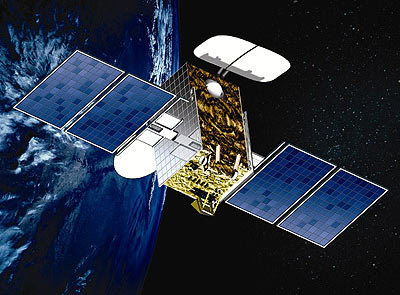O3B: Funded for Launch
Posted by Sam Churchill on November 29th, 2010O3b, a Google-backed satellite venture that aims to provide Internet services to a population of over 3 billion people, has raised US$1.2 billion from a group of investors and banks, reports the WSJ, enough to see it through to launch in 2013.
O3b is now “fully funded,” Chief Executive Officer Mark Rigolle said, adding that the company may “plan incremental capex in coming years depending on the speed of growth of the business.”
 O3b, which stands for the “Other 3 billion”,aims to deliver emerging markets in Latin America, Africa, the Middle East, Asia and Australia. “Fiber is not an option in the Amazon, or in Indonesia with thousands of islands,” said Chief Executive Mark Rigolle.
O3b, which stands for the “Other 3 billion”,aims to deliver emerging markets in Latin America, Africa, the Middle East, Asia and Australia. “Fiber is not an option in the Amazon, or in Indonesia with thousands of islands,” said Chief Executive Mark Rigolle.The satellites have a unique middle earth orbit, around the equatorial arc, four times closer than regular geostationary satellites. Each 700kg satellite will operate in the Ka-band (20/30 GHz), with 12 steerable antennas. Ten steerable beams, with 1.2Gbps per beam, connect to its seven operational regions. Two steerable beams link to O3b’s ground stations that are linked to fiber networks.
O3B will provide cellular carriers with backhaul and providing access to approximately 70 percent of the world’s population. Internet service from O3B should cost about $500 per megabyte per month, down from about $3,000 per MB per month now via existing satellites. O3b system will provide Telcos and ISPs with low-cost backhaul to connect their 3G, WiMAX and fixed-line networks to the rest of the world.
Headquartered in Jersey, the Channel Islands, SES will remain O3b’s largest shareholder following the equity fundraising. New shareholders include Satya Capital, a private equity firm backed by Mo Ibrahim, a Sudanese telecoms tycoon, and the Development Bank of Southern Africa. O3b has finalised a $510m senior debt facility with HSBC, ING, Crédit Agricole and Dexia.
O3b plans to begin commercial service during the first half of 2013 following the launch of the first eight satellites by Arianespace with a Soyuz launcher from French Guiana. O3b was founded by Greg Wyler, a technology entrepreneur. Thales Alenia Space is currently building O3b’s first eight Ka-band satellites. O3b is fully funded for the launch of these, and will generate enough cash to expand its fleet once the service begins, Mr. Rigolle said.
O3b plans to begin commercial service during the first half of 2013 following the launch of the first eight satellites by Arianespace with a Soyuz launcher from French Guiana. O3b was founded by Greg Wyler, a technology entrepreneur. Thales Alenia Space is currently building O3b’s first eight Ka-band satellites. O3b is fully funded for the launch of these, and will generate enough cash to expand its fleet once the service begins, Mr. Rigolle said.
The FT claims O3b has already signed deals worth between US$500 million and US$600 million with customers that want to use the company’s satellite infrastructure. The project needs a minimum of six satellites in orbit, but the intention is to put up perhaps as many as 20 eventually.
Meanwhile, Arianespace has successfully launched a Hylas satellite last friday on anAriane 5 rocket. Hylas is an acronym for Highly Adaptable Satellite.
Hylas 1, will operate in the Ka-band (26.5-40GHz), supplying up to 350,000 residential customers in Europe with satellite broadband. A Ku-band, direct television broadcast capability, is also included. British start-up company called Avanti Communicationslaunched the $159 million satellite into orbit Friday, the first of two satellites it plans to use to deliver broadband to as many as 1.2 million customers across Europe, the Middle East and Africa. ESA says several innovations are incorporated into Hylas-1.
It was ESA’s first private-public partnership to result in an operational mission.Satellite broadband is gaining acceptance across Europe as a broadband-access technology, but the economics are still unclear, said Ben Tudor, a senior analyst at Current Analysis.
The Ariane 5 launch carried two spacecraft. Intelsat 17 separated from the Ariane 5 launcher first. It is bound for a position over the Indian Ocean, to distribute video and other communications services to customers in Europe, Africa, the Middle East and Asia.
It will join Intelsat 10 at an adjacent location and replace Intelsat 702, an aging satellite launched in 1994.
Intelsat’s next launch, in the first quarter of 2011, is for their New Dawn spacecraft, which will carry 16 Ku and 14 C transponders, optimized to deliver wireless backhaul, broadband and television programming. It will be located at 32.9 degrees East Longitude to cover the Middle East, part of Europe, Africa and Sub-Saharan regions, and is scheduled to be in service in early 2011.
ABI Research says more than two billion of the world’s population is now being covered by high-speed data networks, with more than 500 3G networks, and over 300 WiMAX and LTE announcements worldwide.
According to marketresearch.com, the global internet access market grew by 9.4% in 2009 to reach a value of $160 billion and is forecast to have a value of $230 billion in 2014. The global internet access market grew by 9.6% in 2009 to reach a volume of 500,828 thousand subscribers and is forecast to have a volume of 732,953 thousand subscribers, in 2014.
source: dailywireless.org









No comments:
Post a Comment